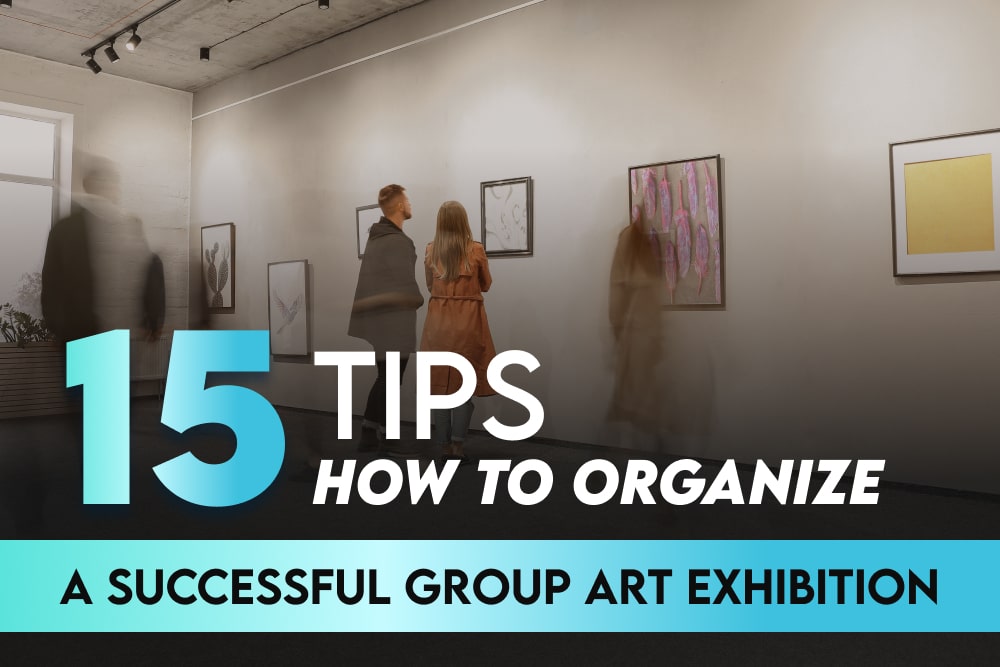

Head of HR at Rent For Event

Head of HR at Rent For Event
Organizing a successful group art exhibition requires careful planning, attention to detail, and a clear vision.
Whether you are an artist, curator, or event organizer, these 15 tips will guide you through the process. This way, you can create a captivating art event that engages and delights your audience.
Let’s explore the essential steps to ensure a memorable and well-executed showcase. This article will teach you how to curate an art show and how to plan the logistics.

Here are the top 15 tips if you’re wondering how to plan an art exhibition:
Find captivating art exhibition themes and concepts. Having a theme serves as the foundation for the entire event. It must provide a unifying message that resonates with your target audience.
Consider the emotions, ideas, or narratives you wish to convey through the artworks on display.
Curating an exhibition involves carefully selecting artworks that complement each other. Meanwhile, showcase the unique styles and perspectives of the participating artists.
Aim for a cohesive collection that flows seamlessly. It should tell a visual story to visitors.
Look for works that resonate with the chosen theme. Additionally, create a harmonious viewing experience.
To create an optimal exhibition experience, plan your gallery space thoughtfully. Develop an art gallery floor plan. This allows visitors to navigate the exhibition with ease.
Consider the flow of traffic and the placement of artworks. Be mindful of the availability of adequate lighting and wall space as well.
Optimize the gallery space plan. This way, you can maximize the impact of each artwork and ensure a pleasant viewing experience.
Engage artists whose work aligns with your exhibition’s theme and concept. Foster open communication with the artists,
make sure to provide clear guidelines. You should also ensure they understand the vision and goals of the event.
Encourage collaboration and shared ideas among the participating artists. This can enhance the overall quality and cohesion of the exhibition.
Promotion and advertising play a crucial role in attracting a diverse audience.
Use channels such as social media platforms, art websites, and local press. They can help generate buzz and spread the word about your exhibition.
Create visually appealing content that showcases the artists and their works. This can entice potential visitors to attend.
Invest in high-quality display equipment. This enhances the visual impact of your exhibition.
Consider options like led screen rental, projector and screen rental, and lighting rental. These can help you create an immersive and captivating environment that highlights the art pieces.
A well-executed display can elevate the overall ambiance and make the artworks shine.
Establish clear guidelines and deadlines for the participating artists. Provide them with detailed instructions regarding artwork submission requirements. Give notes about the installation process, labeling, and any specific display requirements as well.
Clear guidelines and deadlines will help streamline the organization and installation of artwork.
Build anticipation and engage the community. Do so by organizing pre-exhibition events.
These events can include artist talks, workshops, or panel discussions. These provide insights into the artworks and the exhibition’s theme.
These events offer valuable experiences to attendees. They also create opportunities for networking and collaboration among artists and art enthusiasts.
Coordinate logistics and ensure the security of artworks.
Consider partnering with an experienced event production company. They can handle the technical aspects, transportation, and installation of artwork.
Ensure that the artworks are properly insured, handled, and transported. Focus on their protected throughout the duration of the event.
Recruit a team to assist with the smooth operation of the exhibition.
Assign specific roles and responsibilities. This ensures that all tasks, such as greeting visitors and monitoring artwork, are handled effectively.
Engaging volunteers and staff can enhance the overall visitor experience. It also ensures the exhibition runs smoothly.
Offer visitors clear and concise information about the artworks. This can enhance their understanding and appreciation of the exhibition.
Use signage, wall labels, or interactive displays to share details about the artists. It can also include their inspiration and the techniques employed in their creations.
Providing informative and engaging interpretive materials can enrich the visitor experience.
Create opportunities for audience interaction within the exhibition. This can make your event more memorable.
Incorporate interactive elements. This includes feedback boards, workshops, or interactive installations.
Invite visitors to participate and express their thoughts. Encourage audience engagement. This fosters a deeper connection with the artworks and stimulates conversations.
Forge partnerships with local museums, art schools, or cultural institutions. This expands the reach of your exhibition.
Collaborative efforts can result in cross-promotion. It also increases exposure and gives access to a wider audience.
Building relationships with other art-related organizations creates a more vibrant and interconnected art community.
Celebrate the launch of your art exhibition by hosting an opening reception.
Provide refreshments to create a welcoming atmosphere. You can also offer opportunities for artists and visitors to connect and discuss the artworks.
An opening reception serves as a platform to showcase the artists. It also generates excitement and creates a memorable experience for attendees.
After the exhibition concludes, seek feedback from artists, visitors, and your team. Their perspectives and insights provide valuable information for future improvements.
Evaluate the strengths and weaknesses of the event. Make sure to identify areas for enhancement.
Learning from each experience will help you refine and elevate future exhibitions.
Organizing a group art exhibition offers numerous advantages. It benefits the participating artists, the organizers, and the community as a whole.
Let’s explore some of the key advantages of curating an exhibition:
A group art exhibition provides artists with a platform to showcase their work. It aids them in expressing their artistic visions.
It also allows artists to connect with one another. This fosters a sense of community and collaboration.
Organizing a group exhibition lets you create an opportunity for artists to network. Through this, they can share ideas and learn from each other’s techniques and perspectives.
A group art exhibition can significantly increase their exposure and visibility within the art community.
It offers a chance to showcase their talent to a wider audience. This includes art enthusiasts, collectors, gallery owners, and curators.
The exhibition serves as a springboard for artists to establish their presence. It helps them gain recognition in the art world.
A group art exhibition invites the public to engage with and appreciate art in a meaningful way.
It provides an opportunity for viewers to experience diverse artistic styles. They’ll also gain access to various themes and techniques.
Through exhibitions, visitors can gain a deeper understanding of the artists’ creative processes. Artists can also talk about their motivations and messages.
Exhibitions often include interpretive materials. You can also provide guided tours or interactive elements that enhance the educational aspect of the event.
Group art exhibitions contribute to the cultural enrichment of a community.
They provide an avenue for people from different backgrounds to share experiences. It also helps them appreciate the power of art.
Exhibitions can foster dialogue and spark discussions. Plus, it raises awareness about social, cultural, or environmental issues.
Organizing a group art exhibition allows you to establish partnerships. It also facilitates collaboration with artists and art organizations.
Through collaborative efforts, you can cross-promote exhibitions. This helps you share resources and expand your network within the art community.
Collaborations can lead to future opportunities for joint projects. You can open opportunities for curatorial endeavors or further community engagement.
Organizing a group art exhibition offers valuable professional development opportunities.
It provides hands-on experience in creating a gallery show. This includes project management, curation, marketing, logistics, and event planning.
These responsibilities let you enhance your skills. These also expand your knowledge of the art industry. Plus, they help you build a strong portfolio of successful exhibitions.
Group art exhibitions can have a positive economic impact on the local community. They attract visitors from near and far. This stimulates tourism, local businesses, and the hospitality industry.
Visitors often explore other cultural attractions. Moreover, they dine in local establishments or engage in retail activities. This boosts the local economy.
Additionally, art collectors attending the exhibition may contribute to the sales and support of artists’ work.
Organizing a successful group art exhibition requires meticulous planning, thoughtful curation, and effective execution. Every step plays a vital role in creating a successful showcase.
Embrace the opportunity to present a collection of diverse artworks. These can inspire, provoke thought, and contribute to the ever-evolving art community.
Rent for Event is your trusted partner for all your event rental needs. Get in touch now, and let us transform your vision into a reality. Together, we’ll make your event an unforgettable success!